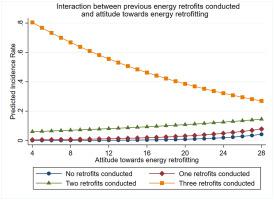Energy Policy ( IF 9 ) Pub Date : 2021-08-06 , DOI: 10.1016/j.enpol.2021.112451 Lars Even Egner 1 , Christian A. Klöckner 1

|
Energy retrofitting of private housing is fundamental to reducing the environmental footprint of the building stock, and energy efficiency policies are based on assumptions of the effects of retrofitting, including those on further retrofitting, also called temporal spillover. No study has directly investigated the impact of energy retrofitting on future energy retrofits.
Our results (N = 6402) show that respondents who completed energy retrofits in the past three years are significantly more likely to undertake new energy retrofits (IRR = 3.449). This is also true when controlling for demographic variables (IRR = 2.752), attitude and self-efficacy. Younger age, lower income, higher investment capacity, a more positive attitude, and higher self-efficacy toward retrofitting are associated with more energy retrofits.
Since a strong temporal spillover effect is present in energy retrofitting, we suggest that locking in the energy building standard to a suboptimal level after partial retrofitting is not as great a challenge as previously thought. Moreover, due to the distribution of retrofits, the average number of retrofits undertaken is a misleading indicator of the trends in a nation's building stock, and subsidizing small scale-retrofits may provide major benefits for households' overall environmental footprint.
中文翻译:

私人住宅能源改造的时间溢出效应:家庭能源改造的分布及对补贴政策的影响
私人住宅的能源改造是减少建筑存量环境足迹的基础,能源效率政策基于改造效果的假设,包括进一步改造的效果,也称为时间溢出。没有研究直接调查能源改造对未来能源改造的影响。
我们的结果 (N = 6402) 表明,在过去三年中完成能源改造的受访者更有可能进行新能源改造 (IRR = 3.449)。在控制人口统计学变量 (IRR = 2.752)、态度和自我效能感时也是如此。更年轻的收入、更高的投资能力、更积极的态度和更高的改造自我效能与更多的能源改造有关。
由于能源改造存在很强的时间溢出效应,我们认为在部分改造后将能源建筑标准锁定在次优水平并不像以前认为的那么大。此外,由于改造的分布,进行的平均改造次数是一个国家建筑存量趋势的误导性指标,补贴小规模改造可能为家庭的整体环境足迹提供主要好处。


























 京公网安备 11010802027423号
京公网安备 11010802027423号